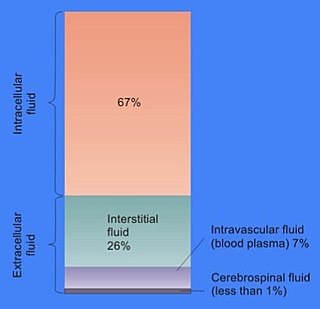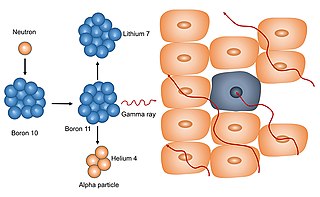Related Research Articles

Carotenoids, also called tetraterpenoids, are yellow, orange, and red organic pigments that are produced by plants and algae, as well as several bacteria, and fungi. Carotenoids give the characteristic color to pumpkins, carrots, parsnips, corn, tomatoes, canaries, flamingos, salmon, lobster, shrimp, and daffodils. Carotenoids can be produced from fats and other basic organic metabolic building blocks by all these organisms. The only land dwelling arthropods known to produce carotenoids are aphids, and spider mites, which acquired the ability and genes from fungi. It is also produced by endosymbiotic bacteria in whiteflies. Carotenoids from the diet are stored in the fatty tissues of animals, and exclusively carnivorous animals obtain the compounds from animal fat. In the human diet, absorption of carotenoids is improved when consumed with fat in a meal. Cooking carotenoid-containing vegetables in oil and shredding the vegetable both increase carotenoid bioavailability.

Photodynamic therapy (PDT), is a form of phototherapy involving light and a photosensitizing chemical substance, used in conjunction with molecular oxygen to elicit cell death (phototoxicity).

Tumor hypoxia is the situation where tumor cells have been deprived of oxygen. As a tumor grows, it rapidly outgrows its blood supply, leaving portions of the tumor with regions where the oxygen concentration is significantly lower than in healthy tissues. Hypoxic microenvironements in solid tumors are a result of available oxygen being consumed within 70 to 150 μm of tumour vasculature by rapidly proliferating tumor cells thus limiting the amount of oxygen available to diffuse further into the tumor tissue. In order to support continuous growth and proliferation in challenging hypoxic environments, cancer cells are found to alter their metabolism. Furthermore, hypoxia is known to change cell behavior and is associated with extracellular matrix remodeling and increased migratory and metastatic behavior.

In cell biology, extracellular fluid (ECF) denotes all body fluid outside the cells of any multicellular organism. Total body water in healthy adults is about 60% of total body weight; women and the obese typically have a lower percentage than lean men. Extracellular fluid makes up about one-third of body fluid, the remaining two-thirds is intracellular fluid within cells. The main component of the extracellular fluid is the interstitial fluid that surrounds cells.

Glioblastoma, previously known as glioblastoma multiforme (GBM), is one of the most aggressive type of cancers that begin within the brain. Initially, signs and symptoms of glioblastoma are nonspecific. They may include headaches, personality changes, nausea, and symptoms similar to those of a stroke. Symptoms often worsen rapidly and may progress to unconsciousness.

Tirapazamine (SR-[[4233]]) is an experimental anticancer drug that is activated to a toxic radical only at very low levels of oxygen (hypoxia). Such levels are common in human solid tumors, a phenomenon known as tumor hypoxia. Thus, tirapazamine is activated to its toxic form preferentially in the hypoxic areas of solid tumors. Cells in these regions are resistant to killing by radiotherapy and most anticancer drugs. Thus the combination of tirapazamine with conventional anticancer treatments is particularly effective. As of 2006, tirapazamine is undergoing phase III testing in patients with head and neck cancer and gynecological cancer, and similar trials are being undertaken for other solid tumor types.

Crocin is a carotenoid chemical compound that is found in the flowers crocus and gardenia. Crocin is the chemical primarily responsible for the color of saffron.

Crocetin is a natural apocarotenoid dicarboxylic acid that is found in the crocus flower together with its glycoside, crocin, and Gardenia jasminoides fruits. It forms brick red crystals with a melting point of 285°C.

Estramustine phosphate (EMP), also known as estradiol normustine phosphate and sold under the brand names Emcyt and Estracyt, is a dual estrogen and chemotherapy medication which is used in the treatment of prostate cancer in men. It is taken multiple times a day by mouth or by injection into a vein.

Efaproxiral (INN) is an analogue of the cholesterol drug bezafibrate developed for the treatment of depression, traumatic brain injury, ischemia, stroke, myocardial infarction, diabetes, hypoxia, sickle cell disease, hypercholesterolemia and as a radio sensitiser.

A radiosensitizer is an agent that makes tumor cells more sensitive to radiation therapy. It is sometimes also known as a radiation sensitizer or radio-enhancer.

Temozolomide (TMZ), sold under the brand name Temodar among others, is a medication used to treat some brain tumors such as glioblastoma multiforme or anaplastic astrocytoma. It is taken by mouth or via intravenous infusion.

Neutron capture therapy (NCT) is a radio-therapeutic modality for treating locally invasive malignant tumors such as primary brain tumors, recurrent cancers of the head and neck region, and cutaneous and extracutaneous melanomas. It is a two-step procedure: first, the patient is injected with a tumor-localizing drug containing the non-radioactive isotope boron-10 (10B), which has a high propensity to capture low energy "thermal" neutrons. The neutron cross section of 10B is 1,000 times greater than that of the other elements, such as nitrogen, hydrogen, and oxygen, that are present in tissues. In the second step, the patient is radiated with epithermal neutrons, the sources of which in the past have been nuclear reactors and now are accelerators that produce higher energy epithermal neutrons. After losing energy as they penetrate tissue, the resultant low energy "thermal" neutrons are captured by the 10B atoms. The resulting decay reaction yields high-energy alpha particles that kill the cancer cells that have taken up sufficient quantities of 10B. All of the clinical experience to date with NCT has been with the non-radioactive isotope boron-10, and hence this radio-therapeutic modality is known as boron neutron capture therapy (BNCT). The use of another non-radioactive isotope, such as gadolinium (Gd), has been limited to experimental animal studies and has not been used clinically. BNCT has been evaluated clinically as an alternative to conventional radiation therapy for the treatment of malignant brain tumors such as glioblastomas, which presently are incurable, and more recently, locally advanced recurrent cancers of the head and neck region and, much less frequently, superficial melanomas primarily involving the skin and genital region.

Diffusion Pharmaceuticals Inc (NASDAQ:DFFN) is a publicly traded biotechnology and drug development company based in Charlottesville, Virginia, U.S. It was co-founded in 2001 by American life sciences entrepreneur David Kalergis and University of Virginia Chemical Engineering Professor John L. Gainer. Gainer is the inventor of the company’s platform technology of oxygen diffusion-enhancing compounds and its lead drug, trans sodium crocetinate (TSC). TSC acts to increase the rate at which oxygen moves through blood plasma by the process of diffusion, a phenomenon that forms the basis for the company's name. On January 8, 2016, the formerly privately-held company merged with Restorgenex Cororation to become a publicly-traded NASDAQ-listed company with the trading symbol DFFN. TSC and other oxygen diffusion-enhancing compounds, including bipolar trans carotenoid salts, have been investigated by Diffusion Pharmaceuticals for treatment of conditions associated with reduced oxygen availability in tissues (hypoxia). Most recently, Diffusion has begun the initiation of clinical trials in the U.S. and Eastern Europe for the use of trans sodium crocetinate in the treatment of COVID-19 patients suffering from respiratory distress-related oxygen deficiency and the risk of multiple organ failure.

John L. Gainer is an American chemical engineer and co-founder and former chief scientific officer of Diffusion Pharmaceuticals, a biotechnology and pharmaceutical company based in Charlottesville, Virginia, U.S. Professor Gainer retired from his position as Chief Science Officer of Diffusion Pharmaceuticals in March, 2020.

David Kalergis is an American life sciences entrepreneur and the Co-founder, Chairman and Chief Executive Officer of Diffusion Pharmaceuticals Inc, a Charlottesville, Virginia, U.S.-based biotechnology and pharmaceutical company. He co-founded the company in 2001 with American chemical engineer John L. Gainer. Kalergis became Diffusion's CEO in 2004, a position in which he has drawn extensively on his career in law, business, and clinical trials implementation. Under Kalergis' leadership, Diffusion Pharmaceuticals has been cited for advancing improved cancer treatments and is currently conducting multicenter clinical trials of a novel therapeutic for brain cancers, including glioblastoma multiforme. Diffusion Pharmaceuticals is also currently conducting clinical trials for the treatment of oxygen deficiencies associated with COVID-19 and acute stroke.
Sodium MRI is a specialised magnetic resonance imaging technique that uses strong magnetic fields, magnetic field gradients, and radio waves to generate images of the distribution of sodium in the body, as opposed to more common forms of MRI that utilise protons present in water (1H-MRI). Like the proton, sodium is naturally abundant in the body, so can be imaged directly without the need for contrast agents or hyperpolarization. Furthermore, sodium ions play a role in important biological processes via their contribution to concentration and electrochemical gradients across cellular membranes, making it of interest as an imaging target in health and disease.
Carotenoid complexes are physical associations of carotenoids with other molecules.

Furegrelate, also known as 5-(3-pyridinylmethyl)benzofurancarboxylic acid, is a chemical compound with thromboxane enzyme inhibiting properties that was originally developed by Pharmacia Corporation as a drug to treat arrhythmias, ischaemic heart disorders, and thrombosis but was discontinued. It is commercially available in the form furegrelate sodium salt.

BOLD-100, or sodium trans-[tetrachlorobis (1H-indazole)ruthenate(III)], is a ruthenium-based anti-cancer therapeutic in clinical development. As of November 2021, BOLD-100 was being tested in a Phase 1b clinical trial in patients with advanced gastrointestinal cancers in combination with the chemotherapy regimen FOLFOX. BOLD-100 is being developed by Bold Therapeutics Inc.
References
- 1 2 3 USpatent 8206751,Gainer J,"New Class of Therapeutics that Enhance Small Molecule Diffusion",issued 2009-04-30
- 1 2 3 4 Gainer, J (2008). "Trans-sodium crocetinate for treating hypoxia/ischemia". Expert Opinion on Investigational Drugs. 17 (6): 917–924. doi:10.1517/13543784.17.6.917. PMID 18491992. S2CID 71663644.
- ↑ Gainer J; G.M. Chisolm III (1974). "Oxygen diffusion and atherosclerosis". Atherosclerosis. 19 (1): 135–138. doi:10.1016/0021-9150(74)90049-5. PMID 4810465.
- ↑ Abdullaev F, Espinosa-Aguirre J (2004). "Biomedical properties of saffron and its potential use in cancer therapy and chemoprevention trials". Cancer Detection and Prevention. 28 (6): 426–432. doi:10.1016/j.cdp.2004.09.002. PMID 15582266.
- ↑ Lapchak P (2010). "Efficacy and safety profile of the carotenoid trans sodium crocetinate administered to rabbits following multiple infarct ischemic strokes: A combination therapy study with tissue plasminogen activator". Brain Research. 1309: 136–145. doi:10.1016/j.brainres.2009.10.067. PMID 19891959. S2CID 25369069.
- 1 2 "Safety and Efficacy Study of Trans Sodium Crocetinate (TSC) With Concomitant Radiation Therapy and Temozolomide in Newly Diagnosed Glioblastoma (GBM)". ClinicalTrials.gov. November 2011. Retrieved 18 September 2012.
- ↑ Sheehan, Jason; et al. (2008). "Use of trans sodium crocetinate for sensitizing glioblastoma multiforme to radiation". Journal of Neurosurgery. 108 (5): 972–978. doi:10.3171/JNS/2008/108/5/0972. PMID 18447715.
- ↑ "Diffusion Pharmaceuticals Announces FDA Accelerated Review of TSC Clinical Development Plan to Treat COVID-19 Patients with ARDS". Diffusion Pharmaceuticals. May 5, 2020. Retrieved May 25, 2020.
- 1 2 3 USpatent 7919527,Gainer J&Grabiak R,": Bipolar trans carotenoid salts and their uses",issued 2011-04-05
- 1 2 Laidig, K.E., J.L. Gainer, V. Daggett (1998). "Altering Diffusivity in Biological Solutions through Modification of Solution Structure and Dynamics". Journal of the American Chemical Society. 120 (36): 9394–9395. doi:10.1021/ja981656j.
{{cite journal}}: CS1 maint: multiple names: authors list (link) - 1 2 Cannon, Joseph G (1999). Pharmacology for Chemists. New York: Oxford University Press. ISBN 978-0841235243.
- ↑ Manabe H, et al. (2010). "Protection against focal ischemic injury to the brain by trans-sodium crocetinate". Journal of Neurosurgery. 113 (4): 802–809. doi:10.3171/2009.10.JNS09562. PMC 3380430 . PMID 19961314.
- ↑ Starr, Cecie; McMillan, Beverly (2012). Human Biology (9th ed.). ISBN 978-0840061669.